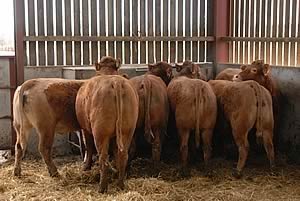 |
|||||||||
|
|||||||||||||||||||
|
|
Delivering to Exact Deadweight Spec will Pay Beef Finishers Every abattoir is different, even if they belong to the same company, and each of them specialises in selling beef from specific types of cattle to equally individual customers.
And so, says the National Beef Association, finishers selling deadweight should not fall into the trap of thinking that the majority of abattoirs are happy to accept the same type of stock - or be enthusiastic in price terms about unloading an extremely mixed batch of steers, heifers and cows compared with a delivery of cattle which exactly hit its preferred specification. “Now that slaughter cattle prices are moving into new territory finishers who can deliver the right type of cattle to a number of different plants will make even more money if they concentrate harder on selection before they load their lorry,” explained NBA director, Kim Haywood. “All abattoirs are specialists. Obvious examples include one company which prefers Angus cross heifers with a minimum carcase weight of 260 kilos while another is only interested in cows which will produce carcases weighing over 340kg and classify 4H because it has a good export customer.” “Another plant might have an equally good export order for plus 400 kilo bull carcases and be able to take animals that would be heavily discounted if they turned up at an abattoir supplying the domestic market while companies that prefer typically commercial 320-360kg R4L steers will pay a good price for them but discount anything outside their spec – including E and U+ conformation cattle that should really have been sold elsewhere.” And according to the NBA the carcase preferences that dictate an abattoir’s price premiums are not always as obvious as this and can at times be quite subtle. “Experienced sellers already know there are plants that are happy to take plain steers and heifers and they use them to mop up their tail enders after their top draw has been sent to a better payer,” said Ms Haywood. “However these differences are disguised by the fact that throughput hungry abattoirs will rarely reject unsuitable cattle that turn up in their lairage – although they will hit them with discounts that ought to make the seller’s eyes water.” “Feeders that have not already done so should make themselves as familiar as they can do with the price grids, weight and age specifications, and processing costs per head, offered by every plant within reasonable delivery distance, then work out which one will pay most for every individual animal in their shed.” “Compromises should only be made if there are not enough cattle of the same type to make up a load or the delivery cost is bigger than the price bonus. But cattle are already so short that it is unlikely that any potential sale will be rejected so finishers who make more effort to aim their animals at exactly the right customer will earn even more money than they are doing already,” Ms Haywood added.
|
||||||||||||||||||

|
|
||||||||||||||||||
| home | agri-services | pedigree
pen | news | dairy | beef | machinery BPS | property | organisations | site map |
|||||||||||||||||||


